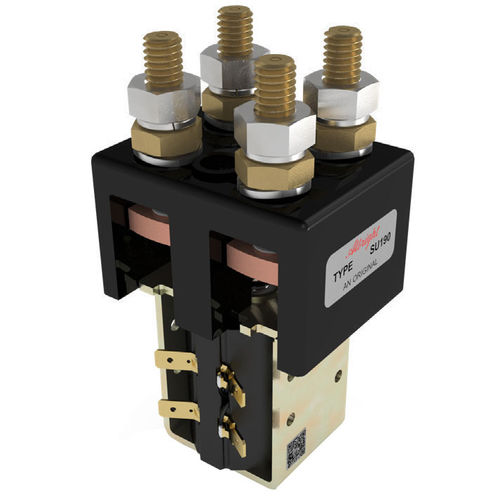
- Electricity - Electronics
- Switch and Relay
- Power contactor
- ALBRIGHT INTERNATIONAL
DPST-NO contactor SU19 seriespowerelectromechanicalsemiconductor

Add to favorites
Compare this product
Characteristics
- Function
- power
- Technology
- electromechanical, semiconductor
- Electrical characteristics
- DC, AC, 2-pole, inductive switching, resistive switching
- Contact configuration
- DPST-NO
- Applications
- for motors, power distribution
- Other characteristics
- for capacitor switching, heavy-duty capacitor
- Primary current
Max.: 635 A
250 A, 350 A
Min.: 300 A
- Load voltage
96 V, 250 V
Description
The SU190 is an up-rated variant of the SW190 Series of contactor primarily designed to switch heavy duty D.C. loads, however it is also capable of switching A.C. loads. The SU190 is suitable for switching Resistive, Capacitive and Inductive loads. Typical applications include electric motors, hydraulic power packs, winches, speed controllers and Power Distribution Systems.
The contactors feature double pole, double breaking main contacts with silver alloy tips, which are weld resistant, hard wearing and have excellent conductivity. The SU190 is easy to install, with M5 tapped holes in the switch frame or a variety of optional brackets available. Electrical connections follow industry standards, with M10 main terminal studs and an option for either 6.3mm standard spade terminals or flying leads on the coil assembly. Mounting can be vertical or horizontal, when vertical the M10 contact studs should point upwards. If the requirement is for downwards orientation we can adjust the contactor to compensate for this.
Rated Fault Current Breaking Capacity (Icn) 5ms Time Constant:(In accordance with UL583*)
Blowouts - 1500A at 96V D.C.
No Blowouts - 1500A at 48V D.C.
Rated Fault Current Breaking Capacity (Icn) Resistive Load:(In accordance with UL508*)
Blowouts - 525A at 96V D.C.
No Blowouts - 525A at 60V D.C.
Catalogs
Related Searches
- Isolator switch
- Contactor
- AC contactor
- Power contactor
- Electromagnetic contactor
- DC contactor
- Motor contactor
- DC isolator switch
- Motor contactor
- Reversing contactor
- Electromechanical contactor
- NO/NC contactor
- Single-pole contactor
- High-voltage contactor
- 2-pole contactor
- SPST-NO contactor
- Capacitor switching contactor
- Power distribution contactor
- Miniature contactor
- Automobile contactor
*Prices are pre-tax. They exclude delivery charges and customs duties and do not include additional charges for installation or activation options. Prices are indicative only and may vary by country, with changes to the cost of raw materials and exchange rates.








